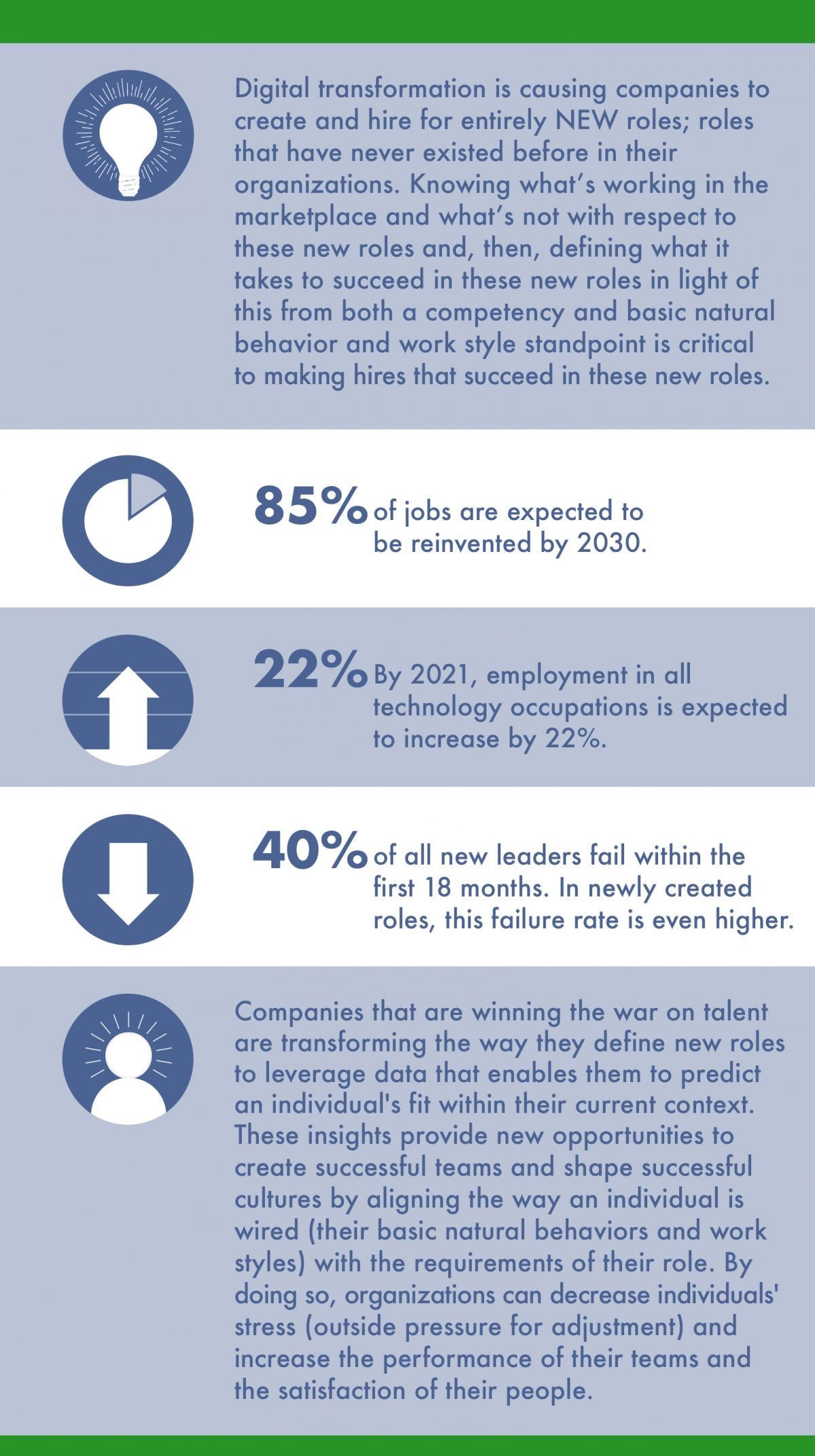Ready For The New Workforce? Hiring For Newly Created Jobs
At A Glance:

Hiring today is very different than it was just five years ago. Digital transformation is changing the way we work and live, and the U.S. has more job openings than unemployed people—a situation some economists call “full employment” since most job seekers land a job fast.
Today’s high-tech environment has created many career opportunities and job positions that didn’t exist before. The U.S. unemployment rate has been hovering around four percent, which has created a unique hiring challenge.1 As well, according to the World Economic Forum Report, sixty percent of industry leaders believe mobile, cloud technology, big data and computing power are driving change in today’s workplace. 2
Many companies are recruiting for new positions that they’ve never recruited for before such as Social Media Managers, Chief Data Scientists, and Cloud Computing Specialists just to name a few. When you combine the challenges of low unemployment with recruiting for newly created positions, it’s clear that recruiters and employers are facing a novel wave of hiring obstacles.
Successful Disciplines for Future Hiring
Timothy Boyce, Partner at iHs Retained Search, notes, “A recent Gartner Study indicated that 85% of jobs are expected to be reinvented by 2030. This means that companies are going to need to hire for a lot of positions over the next ten years that they have never hired for before.” 3 Preparing for what the future holds will require creative thinking and careful planning by hiring managers and HR professionals. Employers need to appreciate that a profound change is happening right now in the types of work and underlying skills that are needed in the “Second Machine Age.” Any organization that wishes to remain relevant and competitive in the Second Machine Age must equip themselves with this new talent and their associated capabilities. And, they need hiring practices that enable them to effectively distinguish the new leaders that are most likely to succeed from those who are not and then successfully attract them to their organization.
iHs Retained Search recommends applying these seven disciplines when hiring for newly created positions:
Discipline 1: Augment Your Job Descriptions with Competency Models
With any search, an organization first needs to determine the criteria by which they’ll evaluate candidates. To be sure, job descriptions that clearly articulate the duties and responsibilities of a role are required. However, crafting a job description is not enough. iHs advocates translating job descriptions into competency models. Competency models take the job description a step further by defining the competencies that are required to successfully discharge the duties and responsibilities of a job; both from a domain expertise and a leadership and management standpoint.
Discipline 2: Use Your Competency Model to Create Interview Guides and Make Sure Your Interviewers Use Them
Scripts can often feel unnatural when spoken aloud. In the hiring process, the objective behind a script or “Interview Guide” is not to make the interviewer(s) feel uncomfortable or robotic, but rather to equip interviews to be able to accurately identify predictors of success and failure that are specific to a particular role. The view that people are rational and logical decision makers is a myth. Real decision-making is rapid, biased, and subconscious. In reality, we rationalize our decisions after the fact. The best interview guides force interviewers to ask questions that are specifically related to the competency model for your role and are designed to help challenge decision maker’s rapid, biased, and subconscious decision making.
Discipline 3: Hire for Fit of People’s Basic/Natural Self with Your Role
The Basic/Natural Self is the way one behaves without any outside pressure for adjustment. And, by the time we reach adulthood, it rarely changes significantly. According to Boyce, “95% of our decision making takes place in the subconscious mind. The Basic/Natural Self is a representation of these subconscious behaviors and it’s very difficult to change. So, you had better hire for it because, once you’ve made your hire, you aren’t going to change it.” As such, iHs advocates using a behavioral assessment instrument such as PDP to build what’s known as a Job Model for the basic natural behaviors and work styles that are optimal for your role. Then, using your behavioral assessment instrument to determine how well candidates’ Basic/Natural Self match or “fit” your Job Model.
Discipline 4: Hire for Passion
Passion fosters progress. If a candidate truly enjoys what they do, they will naturally work harder at it and continue to refine and improve overtime. This is critical with newly created jobs that lack well developed methods and approaches for achieving success. “You can’t teach people passion and it’s very difficult to change the Basic/Natural Self,” explained Boyce. “As such, in addition to hiring for fit with your Job Model, you had better hire someone who is passionate about what you’re going to have them doing.”
Discipline 5: Monitor and Control the Progress of Your Search Regularly
Protracted searches with large, ultimately fruitless time investments in less-than-ideal candidates are, unfortunately, not uncommon in the hiring world. Searches are projects and they need to be managed like them. Who’s making sure you’re hitting the milestones that will ultimately lead to a timely, outstanding hire? Who’s making sure the scope of your search is appropriately changing when you encounter new information or setbacks? Who’s managing actions to closure and ensuring that stakeholders are effectively utilizing your Interview Guides and sticking to your Job Model? What’s the cost to your organization of a delayed hire? What’s the value of the time of the executives involved in your search? The monitoring and controlling process oversees all the tasks and metrics necessary to ensure that your approved and authorized project (your search) is within scope, on time, and on budget so that it proceeds with minimal risk and delivers your intended outcome… a timely, outstanding hire.
Discipline 6: Improve Your Onboarding Process
A recent study found that seventy-six percent of HR leaders agree that onboarding practices are underutilized at their organization. Digging deeper, sixty percent believe the primary goal of an onboarding program should be to integrate employees into the organization’s culture.4 However, culture makes up less than thirty percent of most onboarding activities. Most onboarding programs are simply too short. Some onboarding lasts a few hours to one week, while just ten percent of organizations treat it as a year-long activity.
iHs advocates using a behavioral assessment instrument to introduce your new hire to their new leader and your new hire to their new team then providing these stakeholders with exercises to complete to habituate what is learned. According to Boyce, “Every new hire goes through a process of storming, forming, norming, and then performing. Often times, the norms settled on are not the ones that lead to the highest performance. This is because stakeholders rarely possess mutual understanding of the similarities and differences of their basic natural behaviors and work styles and how these basic natural behaviors and work styles work best together.”
Discipline 7: Work With Experts Who Understand Your New Position
A survey from Glassdoor found that sixty-nine percent of hiring companies made a bad hiring decision based on a flawed interview process, with twenty-two percent reporting insufficient talent intelligence prior to recruiting.5 What’s working out there and what’s not in that new role? What competencies are the driver variables when it comes to predicting success at that new role? What’s it take to attract the best and brightest at that new role and how do you avoid competing with everyone else for them? According to Boyce, “If your job description, competency model, and Job Model don’t take into account intelligence on what’s working out there in these new roles and what’s not and your interview process doesn’t include intelligence on what it takes to succeed at a search for one of these new roles in a timely manner, you’re setting yourself up for failure. Hiring their leaders is one of the most important business decisions an executive will ever make.”
About iHs Retained Search
iHs Retained Search combines expertise from the successful completion of thousands of searches for key contributors at Fortune 1000 and high-growth companies with search leadership by Partners with first-hand, peer-level experience in the searches they lead. iHs’ Partners are all ex-CIOs, VPs or Directors of IT, CMOs, CEOs, and/or Management Consulting Directors or Partners. Using rigorous processes, state-of-the-art research technologies, competency model development and behavioral assessment tools, iHs saves their clients time and helps them make and on-board hires that “fit”—hires that manifest excellence. iHs’ clients evaluate three to four candidates on average before making an offer and iHs has a better than 98% offer acceptance rate over the past 10 years. More than 90% of the candidates presented by iHs to their clients are not active job seekers and are only evaluating their client’s job opportunity. And, 98% of the candidates placed by iHs receive a score of 9 or 10 out of 10 when clients are ask if they would make the same hire again.
To learn more or to start
To learn more or to start a conversation, give us a call at (847) 447-7700



